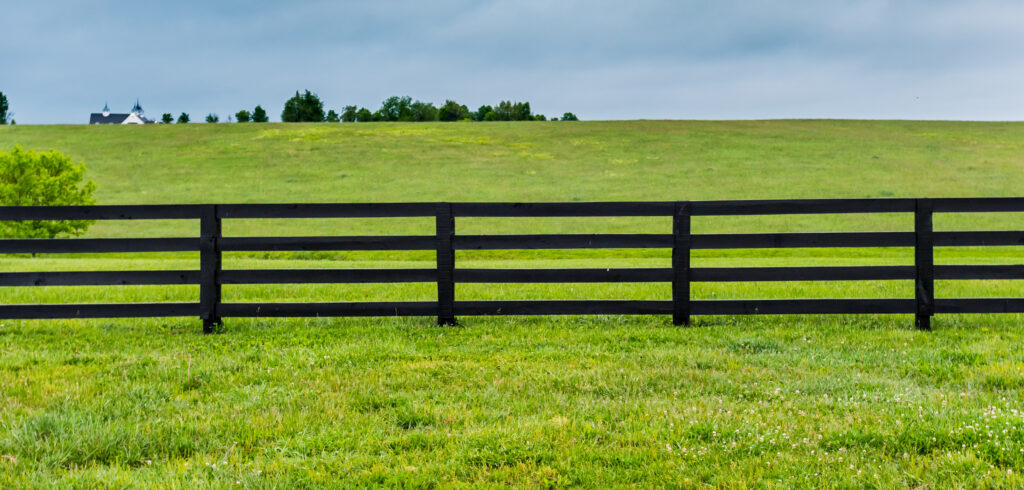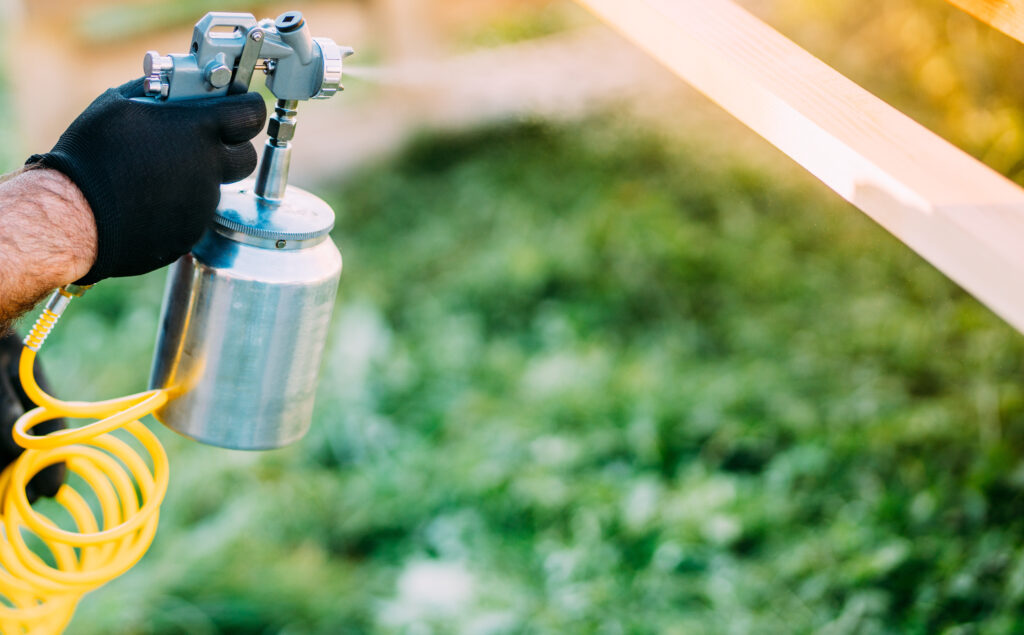
Stock & Noble
Water-based paints for horse fences: Everything you need to know.
- BY Tripti Kakkar
Freshly painted fences are a sight to behold. They enhance the look of your horse property, provide added protection to your fences and increase visibility for horse safety.
Painting your fences is an exciting project, but before you start imagining your gorgeous future fences and get busy choosing the colour and ordering the tub, it’s important to choose the correct coating to suit your requirements.
Ideally, it should be the one that is good for your fence, your property’s aesthetics and the health of the painter and the planet. If you’re looking at water-based paints but aren’t sure if it’s the right option for you then this article will help you in making the right decision.
At Stock & Noble, we provide premium properties across Australia and New Zealand with the best quality fence paints that have been designed specifically for this purpose. When these water-based coatings are correctly applied, you can expect an excellent finish to beautify your property.
At the end of this 5-minute read, you will learn:
- What are water-based paints
- The difference between oil and water-based paints
- Advantages and disadvantages of water-based paints
- The best application practices
What is water-based paint?
When we talk about oil-based or water-based paint, we are actually talking about the type of solvent that is used in the paint, which evaporates as the paint dries. Almost all of the solvent used in water-based paint is water. While oil-based paint contains an organic solvent, such as mineral turpentine in its makeup.
Oil-based paints Vs. Water-based paints for your horse fences
Water-based paints have seen tremendous growth in recent years thanks to technological advancement. Oil-based paints were favoured in the past due to their sheen and quality, but now water-based paints have become more popular and are the future of paint. At Stock & Noble, we only sell water-based paints and it’s natural to think our view will be clouded. However, through this article, we are driven to share our learnings and facts gathered from years of research and will do our best to help you choose the right coat. Eventually, your choice to renew your fences with oil-based or water-based paint entirely depends on you.
The major points of differences between the two are:
Environmental Safety
Oil-based paints are higher in VOCs (Volatile organic compounds) which play a significant role in the formulation of Ozone and fine particulates in the environment. Resulting in an increase of harmful pollutants and toxicity.
In contrast, water-based paints have little to no VOCs and are comparatively safer for our world.
Fume Emissions
Oil-based paints emit harmful fumes to the person applying the paint and those coming in contact with it. The paint takes a long time to dry and continues to release harmful fumes this entire time.
In contrast, water-based paints emit almost zero fumes and are therefore much safer for the person applying the paint.
Time to Dry
Oil-based paints take 6-8 hours on average and can take up more than 20 hours to completely dry up. They don’t lose moisture, rather the solvents in oil-based paints react with air and oxidise, so it’s a slow and tedious process. And remember, those toxic fumes are being emitted the entire time.
In contrast, water-based paint typically dries in 30 minutes, and another coat can be applied in 2-3 hours.
Type of bond
Oil-based paints bond through absorption, meaning they soak into the wood. So, oil-based paints penetrate the wood, get absorbed to finally dry, and reveal the painted fence. It’s a relatively more time-consuming process.
In contrast, water-based paints bond through adhesion, meaning they stick to what is currently there. This implies there needs to be primer used before applying water-based paints. The primer sticks to the wood, then the water-based paint sticks to the primer.
Flammability
Oil-based paint and its cleaners (flammable solvents such as mineral turps and toluene) are fire hazards since they are flammable. Also, rags used to clean up oil-based paints can easily catch fire, or even spontaneously combust, when left in the sun, or if stored improperly. While painting the fences with oil-based paints, one must be extra cautious.
In contrast, water-based paints have no combustible substances in their composition.
UV Resistance
Oil-based paints, do not perform well in UV light. They break down faster and develop a chalky appearance over time. As there is little to no flexibility within the oil-based paint, it is not able to expand and contract with the substrate in differing weather conditions, making cracking more probable.
In contrast, water-based paints are resistant to UV radiation. They are flexible enough to contract and expand with the surface, thus avoiding any cracks from developing on the surface.
6 advantages of water-based paints:
Environmentally Friendly
Water-based paints are very low in Volatile Organic Chemicals, have little to no fumes and almost no nasty chemicals to adversely impact the environment. They are much safer for the planet than the oil-based alternative.
People Friendly
The application of water-based paints needs no masks when brushing or rolling and there are very few health implications for the applicator painting the fences or anyone who becomes exposed to the fresh paint.
Easy to apply and clean
Unlike oil-based paints which need thinners and turpentine during application and clean-up, water-based paints can be simply applied with the recommended brush and cleaned up with water. They also do not have the typical “new paint smell” which can be problematic for some.
Sustain the sheen longer
The oil-based paint’s makeup allows it to achieve a higher sheen when applied; however, over time, it becomes duller. It is true that water-based paints produce a lower sheen finish, but they are often able to sustain this sheen level for longer periods of time than oil-based paints.
Durable
In recent years, there has been a lot of development of water-based paints that allow them to dry really hard and be resistant to wear and tear. Since water-based paints are flexible, they can expand and contract in response to weather conditions, reducing the risk of cracking.
Great for outdoor application
Water-based paints are brilliant for exterior applications, like fences. Due to their UV resistance, water-based paints maintain their sheen levels and colour for a much longer period of time. Also, the flexible makeup allows it to move with the substrate as it expands and contracts with the changing climate, making it the ideal paint for exterior applications, like fences.
2 disadvantages of water-based paints:
Needs ideal weather condition
The application of water-based paint (or any paint) is difficult in adverse weather conditions. Too much humidity or lower temperatures can result in extended drying time, while hot weather can cause the paint to dry too quickly while applying. This can also have an impact on the final painted fences.
Needs more preparation
The success of water-based paint depends on how well the fence has been prepared. Any mould, moss, dirt, old paint and rust should be completely removed through water-blasting before applying the paint. It needs to adhere to a clean surface to perform well, give the desired look and stay for a long time.
Things to consider while applying water-based paint
The correct type of water-based paint can be applied on all kinds of fencing – Timber Post and Rail, Steel Post and Rail and Concrete fences. To get the best results you should follow the best practices of preparation and application as listed below:
1. Preparation is a must
If a Timber fence isn’t prepared well, the paint will crack and peel off way before its expected lifetime.
To prepare, you must give it the required time to weather, properly clean and dry.
If you paint over moss or mould it will result in the paint sticking to the rotten wood instead of the clean layer of wood inside. Which will simply be a waste of your time, effort and money. If you wish you can learn more about how to paint your timber fences.
Also, in the case of Steel fencing, if it’s not prepared with care the grease or rust will not let the paint attach itself to the surface. Consequently, your whole painting project will fail. Here are some of the best practices to paint Steel Post and Rail.
No matter what kind of fencing you have on your property, nothing is protected from the environment forever.
Timber gets dirt, moss, and mould while steel is prone to rust.
So before painting your fences, do the due diligence. Weather your fences for the recommended period and then water blast them to get a clean and dry surface for painting. Once they are properly cleaned the paint will do a much better job of enhancing their look and protecting them from future nature borne problems.
In fact, if you clean the surface which had been previously painted with oil-based paint really well, water-based paint can also work fabulously on it.
2. Temperature is the deciding factor
If you step out on a hot day to paint your fences, the paint will dry up way too quickly making it tough to apply and you won’t be able to achieve a smooth and even finish. The ideal temperature to paint is below 25 degrees, when the paint can be applied easily and smoothly onto your fences. However, there are products like – hot weather additives available at Stock & Noble. They are safe and can be used to make the application easier by preventing the drying of the paint.
3. Apply as per the recommendation
If you don’t follow the manufacturer’s recommendation, it will cost you more time and money, all without achieving the expected result. You will end up using the wrong tools, method of preparation and application, which will lead to this extra cost. It’s a good idea to follow the advice and make sure the paint is applied evenly and thoroughly without much dripping and running. You can choose to do it yourself with a spray gun or hire a professional depending on your time and budget.
4. Always use a primer
If you skip the primer, you’re likely to be disappointed with the final results, no matter how many coats you apply. Aside from possibly getting uneven coverage and bleed-through, the finish coats will be more prone to peeling, chalking, and other imperfections.
In our experience, some surfaces can be painted with self-priming paints, however it’s always better to use a primer and two finish coats of paint. The reason being that primer penetrates the surface and works as a glue to help the paint stick onto the surface in a much stronger way as it is specifically designed as a primer and not a topcoat. It definitely enhances the look and life of your painted fence. Some products might claim to have a topcoat as good as a primer, but the truth is that paint cannot be designed and formulated to do a primer’s job as well as the job of a topcoat.
5. Create a thick film
If you fail to follow the manufacturer’s recommendation on film thickness, your fence would neither have the right finish nor the ideal protection.
It’s important to see the texture of wood underneath, but it’s also important to have the correct thickness of paint film, so it can better protect the surface.
6. Choose a product with high paint solids
Picking a paint with lower volume solids (lower volume solids, imply more water and less paint in your bucket) will give you less amount of paint in every stroke. That means you will be covering your fences with less paint that will last for fewer years, will look weaker and give less protection over time.
For a successful painting project, choosing the right paint plays an integral role. You should pick the one with higher volume solids, so the layers of paint look richer, last longer and protect your fences adequately.
Should you use a water-based paint for your horse fence?
Over the last twenty years, government regulators have understood the need to reduce the amount of VOCs being emitted into the atmosphere. Everything, including paint, now being developed must drive the world towards a healthier and greener future. Consequently, water-based paints are gaining importance and witnessing new developments year after year. In comparison, the consumption and production of oil-based paints is reducing and the ones which exist are focused on finding solutions to reduce harmful solvents in the formulation.
If you choose to go ahead and paint your fences with water-based paints, please remember the best preparation, the best paint and the best application is needed to get the result you want.
Now that you’ve learnt about the advantages and usage of water-based paint, the next obvious question is about the cost of painting your fences.
If you need any more information on choosing the right paint for your steel or timber fences, please speak to our fencing expert.
We are always available to guide you and help create a beautiful, safe and long-lasting equestrian property.



